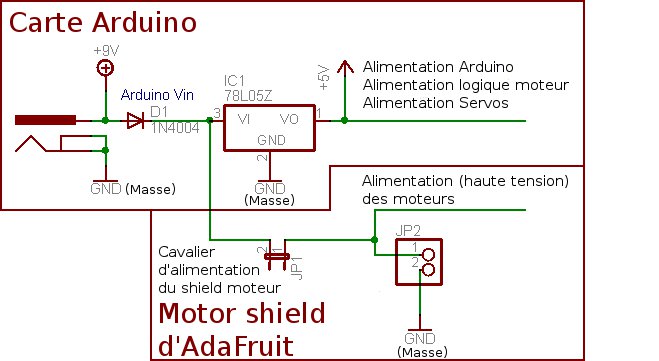Adafruit Motor Shield V2-Alimentation Moteur
Besoin en tension
The first important thing to figure out what voltage the motor is going to use. If you're lucky your motor came with some sort of specifications. Some small hobby motors are only intended to run at 1.5V, but its just as common to have 6-12V motors. The motor controllers on this shield are designed to run from 5V to 12V.
MOST 1.5-3V MOTORS WILL NOT WORK
Besoin en courant
The second thing to figure out is how much current your motor will need. The motor driver chips that come with the kit are designed to provide up to 1.2 A per motor, with 3A peak current. Note that once you head towards 2A you'll probably want to put a heat-sink on the motor driver, otherwise you will get thermal failure, possibly burning out the chip.
| You can't run motors off of a 9V battery so don't waste your time/batteries! |
Use a big Lead Acid or NiMH battery pack. Its also very much suggested that you set up two power supplies (split supply) one for the Arduino and one for the motors. 99% of 'weird motor problems' are due to noise on the power line from sharing power supplies and/or not having a powerful enough supply! Even small DC motors can draw up to 3 Amps when they stall.
Configurer le shield pour des Servos
Servos are powered off of the same regulated 5V that the Arduino uses. This is OK for the small hobby servos suggested. Basically, power up your Arduino with the USB port or DC barrel jack and you're good to go. If you want something beefier, cut the trace going to the optional servo power terminal and wire up your own 5-6V supply!
Configurer le shield pour des moteurs
The DC motors are powered off of a 'high voltage supply' and NOT the regulated 5V. Don't connect the motor power supply to the Arduino's 5V power pin. This is a very very very bad idea unless you are sure you know what you're doing! You could damage your Arduino and/or USB port! There are two places you can get your motor 'high voltage supply' from.
One is the DC barrel jack on the Arduino board The other is the 2-terminal block on the shield that is labeled DC Motor Power 5-12VDC.
The DC Jack on the Arduino has a protection diode so you won't be able to mess things up too bad if you plug in the wrong kind of power. The terminal block as a protection FET so you will not damage the arduino/shield if you wire up your battery supply backwards, but it wont work either!
Here's how it works:

Crédit: AdaFruit Industries www.adafruit.com
Traduction par MCHobby
Une seule alim. pour Arduino + Moteurs
Say a wall adapter or a single battery pack with 6-12VDC output, simply plug it into the DC jack on the Arduino or the 2-pin power terminal block on the shield. Place the power jumper on the motor shield.
Note that you may have problems with Arduino resets if the battery supply is not able to provide constant power, so it is not a suggested way of powering your motor project. You cannot use a 9V battery for this, it must be 4 to 8 AA batteries or a single/double lead acid battery pack.
Arduino alim. via USB + alim. pour moteurs
Plug in the USB cable. Then connect the motor supply to the power terminal block on the shield. Do not place the jumper on the shield.
This is a suggested method of powering your motor project as it has a split supply, one power supply for logic, and one supply for motors
Alim. séparées pour Arduino et moteurs
Plug in the supply for the Arduino into the DC jack, and connect the motor supply to the power terminal block. Make sure the jumper is removed from the motor shield.
| No matter what, if you want to use the DC motor/Stepper system the motor shield LED should be lit indicating good motor power |
Source: Adafruit Motor Shield V2 for Arduino créé par LadyAda pour AdaFruit Industries. Crédit [www.adafruit.com AdaFruit Industries]
Traduit par Meurisse D. pour MCHobby.be
Nos remerciements à Mr Pierre M. pour ses suggestions de correction.
Traduit avec l'autorisation d'AdaFruit Industries - Translated with the permission from Adafruit Industries - www.adafruit.com
Toute référence, mention ou extrait de cette traduction doit être explicitement accompagné du texte suivant : « Traduction par MCHobby (www.MCHobby.be) - Vente de kit et composants » avec un lien vers la source (donc cette page) et ce quelque soit le média utilisé.
L'utilisation commercial de la traduction (texte) et/ou réalisation, même partielle, pourrait être soumis à redevance. Dans tous les cas de figures, vous devez également obtenir l'accord du(des) détenteur initial des droits. Celui de MC Hobby s'arrêtant au travail de traduction proprement dit.